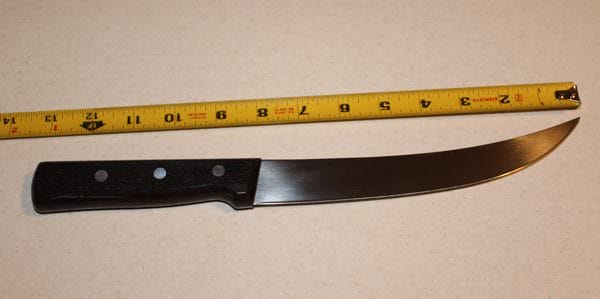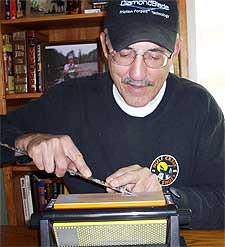

USA -(Ammoland.com)- I’ve written articles lately on a couple of Victorinox Swiss Army Cutlery (VSAC) knives that are great for boning out game and filleting fish. Today I want to write about another VSAC knife that is great to use for processing your game, their 8-inch Breaking knife. You need to have one in your knife arsenal.
I’ve said it a million times but one knife doesn’t suffice for all of your knife related tasks. You need a plethora of knives. You don’t just have one screwdriver do you? No! Here’s a few jobs that I suggest that you’ll use an 8-inch knife on.
If you use a 6-inch (or any smaller bladed knife) when slicing steaks, you’ll end up with sloppy cuts. The end of the steak will look like you hacked it off. You don’t want that. You want smooth cuts so the surface is smooth and sleek. No double cuts or slices. Sure, you can obtain a smooth cut off of a small deer backstrap or off a link of 1 ½-inch sausage and it will look good but if you’re slicing a steak off a Moose ribeye or roast you just need a larger blade. And especially if you’re slicing a rib or strip steak from a primal cut on cattle. The steak will just look a lot smoother and professionally done if you use a VSAC 8-inch Breaking knife.
A second job that requires an 8-inch blade is when you’re trimming fat. If you use a smaller bladed knife the fat will look choppy, whacked up and not of uniform thickness. When trimming fat surfaces, you usually have one of two objectives. Either remove all of the fat or leave 1/4 -inch. Many times you’ll want to leave a ¼-inch to keep the meat moist while cooking. Whether it be a striploin on the grill or smoking a brisket. And you may even want to leave ½-inch of fat.
Now let’s go in a little more detail on how to do the above two jobs more efficiently or maybe just more professionally. It can be challenging to do a good job trimming fat when it is warm. Even though it is harder to cut when it has set up and cold, it is a lot easier to do a smooth trimming job so it doesn’t look hacked and choppy. So chill cuts when you want to trim the fat and leave a smooth fat surface.
When slicing steaks, the goal will be to obtain smooth surfaces and certain thicknesses. Again, it is a lot easier to do with an 8-inch knife and VSAC makes the best one on the market. It has a 1-inch thick, upswept blade which is the perfect design for these tasks.
Unless you’re a professional meat cutter you’re probably going to struggle with cutting steaks of uniform thicknesses. I know I do. Good meat cutters can cut almost perfect 6 ounce steaks all day long of the same thickness. The rest of us….well we struggle.
It’s important to cut your steaks of the same thickness for a few reasons. First, you will end up with more steaks. I remember the first time I tried to slice a ribeye into steaks. I wanted 1-inch steaks. The ribeye was 17-inches long so I should have ended up with 17 steaks, right? Nope. I ended up with 13 because of ununiform steaks. From then on I make little tic marks at an inch across the ribeye and cut it there no matter if I think it’s 1-inch or not.
Secondly, they will cook more uniformly. If someone wants their steak more rare and another more well done you don’t have to check them all. Just leave one on longer for well done and pull one sooner for rarer steaks.
To keep your VSAC 8-inch knife sharp you’ll want to use a smooth steel just like on your boning knives but with a little different technique. On 6-inch and smaller knives I hold the steel still. On longer blades though I move the knife down the steel but I also slightly move the steel or else you’ll get to the end of the steel and not have hit all of the blade. Make sense?
So, as we close here’s my advice if you like to process your own game. Buy a 6-inch VSAC boning knife for boning your game and their 8-inch knife for processing it. I use the 8-inch when making sausage for slicing the meat. It just works better than a smaller one.
(They also work well filleting bigger fish. While King Mackerel fishing in Florida we used them to fillet our catch).
About Tom Claycomb
Tom Claycomb has been an avid hunter/fisherman throughout his life as well as an outdoors writer with outdoor columns in the magazine Hunt Alaska, Bass Pro Shops, Bowhunter.net and freelances for numerous magazines and newspapers. “To properly skin your animal you will need a sharp knife. I have an e-article on Amazon Kindle titled Knife Sharpening for $.99 if you’re having trouble”
